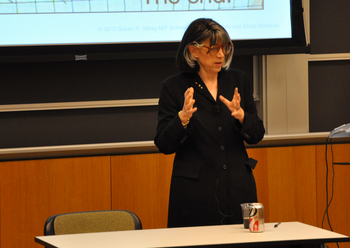
New study categorizes perceptions of regulators in the workplace.
Speaking at a recent seminar sponsored by the Penn Program on Regulation, Professor Susan Silbey of the Massachusetts Institute of Technology argued that various actors within an organization anticipate, discuss, and respond to regulations in very different ways. The approach they take, she says, depends on the amount of contact they have with government officials responsible for ensuring compliance with regulation.
Silbey’s talk was based on research she and her co-author, Garry Gray, conducted in three regulatory settings: university research laboratories, long- and short-haul trucking operations, and a unionized factory in Canada that produced steel and automotive parts.
Noting that most other research on regulation has focused on external forces impinging on regulated firms, Silbey explained that she has been “looking to what is going on inside those organizations.”
In each setting, Silbey said her research involved “deconstructing the fiction of the corporate organization as a person.” Her aim has been to document variations in attitudes about regulation within and across organizations. What she found suggests that each individual’s position within an organization, along with the amount of autonomy and expertise inherent in that position, directly affects attitudes about regulation.
Based on their data from the three settings, Silbey and Gray have developed a typology of attitudes toward the regulator to depict observed variations. The typology identifies three common attitudes: regulators as a threat, an ally, or an obstacle.
 individuals in organizations see regulators as threats, they fear that they will be held personally responsible for regulatory non-compliance. The construction of the regulator as a threat tends to lead to individual and organizational efforts to appear compliant, regardless of whether the appearance of compliance corresponds to the actual goals of the regulation.
individuals in organizations see regulators as threats, they fear that they will be held personally responsible for regulatory non-compliance. The construction of the regulator as a threat tends to lead to individual and organizational efforts to appear compliant, regardless of whether the appearance of compliance corresponds to the actual goals of the regulation.When individuals within organizations view regulatory inspections as threats, they tend to respond by constructing what Silbey characterized as regulatory “Potemkin Villages,” referring to the fake settlements erected to impress Catherine the Great during her tour of Russia. Silbey said that such Potemkin Villages in university laboratories, for example, were built by quickly cleaning labs in anticipation of semi-annual inspections. Ironically, some of this frantic house cleaning may have actually exacerbated the risk of accidents.
When individuals in an organization see the regulator as an ally, they are willing to engage in ongoing, collaborative relationships with regulators to produce compliance and reduce risk. When viewed as allies, regulators are seen as possessing useful expertise and adding value to the specific and technical work of the organization.
By contrast, regulators seen as obstacles lack expert knowledge about the organization’s work processes and offer little value to an organization’s employees. According to Silbey, individuals who possess expertise and autonomy in their workplace but have little direct or frequent interaction with the inspectors tend to view regulators as obstacles.
Even within the same organization, different employees may hold different views of regulators. Silbey cited an example of a university’s attorneys who viewed regulatory inspectors as obstacles, even though the researchers in certain labs governed by the regulations viewed the same inspectors as allies.
Figuring out how to anticipate better the variable reactions to regulators may be helpful in reducing risk and improving regulation. Silbey referred in her seminar to the Gulf Coast oil spill in 2010, one of the worst environmental disasters in history. If those individuals who manage and operate such complex and risky industrial operations view regulators as obstacles or as threats, they may not always act responsibly to reduce the risks that their operations impose on workers and the environment.
![]()



